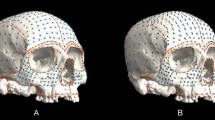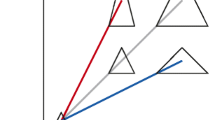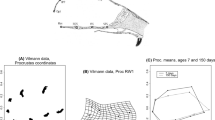Abstract
The form of an organism is the combination of its size and its shape. For a sample of forms, biologists wish to characterize both mean form and the variation in form. For geometric data, where form is characterized as the spatial locations of homologous points, the first step in analysis superimposes the forms, which requires an assumption about what measure of size is appropriate. Geometric morphometrics adopts centroid size as the natural measure of size, and assumes that variation around the mean form is isometric with size. These assumptions limit the interpretation of the resulting estimates of mean and variance in form. We illustrate these problems using allometric variation in shape. We show that superimposition based on subsets of relatively isometric points can yield superior inferences about the overall pattern of variation. We propose and demonstrate two superimposition techniques based on this idea. In subset superimposition, landmarks are progressively discarded from the data used for superimposition if they result in significant decreases in the variation among the remaining landmarks. In outline superimposition, regularly distributed pseudolandmarks on the continuous outline of a form are used as the basis for superimposition of the landmarks contained within it. Simulations show that these techniques can result in dramatic improvements in the accuracy of estimated variance-covariance matrices among landmarks when our assumptions are roughly satisfied. The pattern of variation inferred by means of our superimposition techniques can be quite different from that recovered from full generalized Procrustes superimposition. The pattern of shape variation in the wings of drosophilid flies appears to meet these assumptions. Adoption of superimposition procedures that incorporate biological assumptions about the nature of size and of the variation in shape can dramatically improve the ability to infer the pattern of variation in geometric morphometric data.







Similar content being viewed by others
References
Adams, D. C., Rohlf, F. J., & Slice, D. E. (2004). Geometric morphometrics: Ten years of progress following the ‘revolution’. The Italian Journal of Zoology, 71(9), 5–16. doi:10.1080/11250000409356545.
Akca, M.D. (2003). Generalized procrustes analysis and its applications in photogrammetry. Available at: http://e-collection.ethbib.ethz.ch/ecol-pool/bericht/bericht_363.pdf.
Bookstein, F. L. (1986). Size and shape spaces for landmark data in two dimensions. Statistical Science, 1, 181–242. doi:10.1214/ss/1177013696.
Bookstein, F. L. (1991). Morphometric tools for landmark data: Geometry and biology. Cambridge: Cambridge University Press.
Bookstein, F. L. (1996). Biometrics, biomathematics, and the morphometric synthesis. Bulletin of Mathematical Biology, 58, 313–365. doi:10.1007/BF02458311.
Buckley, P. F., Dean, D., Bookstein, F. L., Friedman, L., Kwon, D., Lewin, J. S., et al. (1999). Three-dimensional magnetic resonance-based morphometrics and ventricular dysmorphology in schizophrenia. Biological Psychiatry, 45(1), 62–67. doi:10.1016/S0006-3223(98)00067-5.
de Celis, J. F. (2003). Pattern formation in the Drosophila wing: The development of the veins. BioEssays, 25, 443–451. doi:10.1002/bies.10258.
Dickinson, M. H., Lehmann, F., & Sane, S. P. (1999). Wing rotation and the aerodynamic basis of insect flight. Science, 284, 1954–1960. doi:10.1126/science.284.5422.1954.
Dryden, I. L., & Mardia, K. V. (1998). Statistical shape analysis. Chichester, U.K.: John Wiley and Sons.
Dryden, I. L., & Walker, G. (1999). Highly resistant regression and object matching. Biometrics, 55, 820–825. doi:10.1111/j.0006-341X.1999.00820.x.
Goodall, C. (1991). Procrustes methods in the statistical analysis of shape. Journal of the Royal Statistical Society: Series B, 53(2), 285–339.
Goodall, C. (1995). Procrustes methods in the statistical analysis of shape revisited. In K. V. Mardia & C. A. Gill (Eds.), Current issues in statistical shape analysis (pp. 18–33). Leeds: Leeds University Press.
Gower, J. C. (1975). Generalized procrustes analysis. Psychometrika, 40, 33–51. doi:10.1007/BF02291478.
Held, L. I. (2002). Imaginal discs: The genetic and cellular logic of pattern formation. Cambridge: Cambridge University Press.
Houle, D., Mezey, J., Galpern, P., & Carter, A. (2003). Automated measurement of drosophila wings. BMC Evolutionary Biology, 3, 25. doi:10.1186/1471-2148-3-25.
Klingenberg, C.P. (2009). Morphometric integration and modularity in configurations of landmarks: Tools for evaluating a-priori hypotheses. Evolution & Development, 11, (in press).
Lele, S. (1993). Euclidean distance matrix analysis (EDMA): Estimation of mean form and mean form difference. Mathematical Geology, 25(5), 573–602. doi:10.1007/BF00890247.
Lele, S. R., & McCulloch, C. E. (2002). Invariance, identifiability, and morphometrics. Journal of the American Statistical Association, 97(459), 796–806. doi:10.1198/016214502388618609.
Lele, S. R., & Richtsmeier, J. T. (2001). An invariant approach to statistical analysis of shapes. London, U.K: Chapman and Hall–CRC press.
Mezey, J. G., & Houle, D. (2005). The dimensionality of genetic variation for wing shape in Drosophila melanogaster. Evolution; International Journal of Organic Evolution, 59(5), 1027–1038.
Mosimann, J. E. (1970). Size allometry: Size and shape variables with characterizations of lognormal and generalized gamma distributions. Journal of the American Statistical Association, 65(330), 930–945. doi:10.2307/2284599.
Richtsmeier, J. T., Lele, S. R., & Cole, T. I. (2005). Landmark morphometrics and the analysis of variation. In B. Hallgrímsson & B. K. Hall (Eds.), Variation: A central concept in biology (pp. 49–68). New York: Academic Press.
Rohlf, F. J. (2003). tpsRegr, version 1.28–1.30. Department of ecology and evolution, Stony brook, NY: State University of New York.
Rohlf, F. J., & Bookstein, F. L. (2003). Computing the uniform component of shape variation. Systematic Biology, 52(1), 66–69. doi:10.1080/10635150390132759.
Rohlf, F. J., & Marcus, L. F. (1993). A revolution in morphometrics. Trends in Ecology & Evolution, 8, 129–132. doi:10.1016/0169-5347(93)90024-J.
Rohlf, F. J., & Slice, D. (1990). Extensions of the procrustes method for the optimal superimposition of landmarks. Systematic Zoology, 39(1), 40–59. doi:10.2307/2992207.
Siegel, A. F., & Benson, R. H. (1982). A robust comparison of biological shapes. Biometrics, 38(2), 341–350. doi:10.2307/2530448.
Slice, D. E. (1998). Morpheus et al.: software for morphometric research, version revision 01-30-98. Department of Ecology and Evolution, Stony Brook, NY: State University of New York.
Slice, D. (2001). Landmark coordinates aligned by procrustes analysis do not lie in Kendall’s shape space. Systematic Biology, 50, 141–149. doi:10.1080/10635150119110.
Sun Microsystems Inc (1992–2006). Java(tm) development kit, version 1.1.8_005. Santa Clara, CA: Sun Microsystems, Inc.
Theobald, D. L., & Wuttke, D. S. (2006). Empirical Bayes hierarchical models for regularizing maximum likelihood estimation in the matrix Gaussian procrustes problem. Proceedings of the National Academy of Sciences of the United States of America, 103(49), 18521–18527. doi:10.1073/pnas.0508445103.
van der Linde, K. & Houle D. (2004–2008). Wings. Tallahassee: Florida State University. Available at: http://www.kimvdlinde.com/morphometrics.
van der Linde, K. (2005–2008). Geometrics package. Tallahassee: Florida State University. Available at: http://www.kimvdlinde.com/morphometrics.
Verboon, P., & Gabriel, K. R. (1995). Generalized procrustes analysis with iterative weighting to achieve resistance. The British Journal of Mathematical and Statistical Psychology, 48, 57–73.
Walker, J. A. (2000). Ability of geometric morphometric methods to estimate a known covariance matrix. Systematic Biology, 49(4), 686–696. doi:10.1080/106351500750049770.
Zelditch, M. L., Straney, D. O., Swiderski, D. L., & Carmichael, A. C. (1990). Variation in developmental constraints in Sigmodon. Evolution; International Journal of Organic Evolution, 44, 1738–1748. doi:10.2307/2409503.
Zelditch, M. L., Swiderski, D. L., Sheets, H. D., & Fink, W. L. (2004). Geometric morphometrics for biologists: A primer. Amsterdam: Elsevier.
Acknowledgments
We thank D. Adams, E. Marquez, F. J. Rohlf, and M. Zelditch for discussions and a reviewer and B. Hallgrimsson for their comments on the manuscript. This work was funded by NSF grant DEB-0129219 to D.H. and by the National Institutes of Health through the NIH Roadmap for Medical Research, Grant U54 RR021813. Information on the National Centers for Biomedical Computing can be obtained from http://nihroadmap.nih.gov/bioinformatics.
Author information
Authors and Affiliations
Corresponding author
Rights and permissions
About this article
Cite this article
van der Linde, K., Houle, D. Inferring the Nature of Allometry from Geometric Data. Evol Biol 36, 311–322 (2009). https://doi.org/10.1007/s11692-009-9061-z
Received:
Accepted:
Published:
Issue Date:
DOI: https://doi.org/10.1007/s11692-009-9061-z




